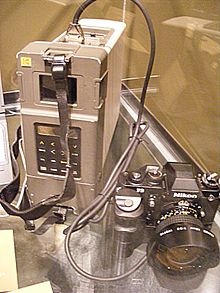- Kodak DCS 100
-
 Kodak DCS 100, based on a Nikon F3 body with Digital Storage Unit, released in May, 1991.
Kodak DCS 100, based on a Nikon F3 body with Digital Storage Unit, released in May, 1991.
The Kodak Professional Digital Camera System or DCS, (unofficially later named the DCS 100,) was the first commercially available DSLR camera. It was mounted on a Nikon F3 body and released by Kodak in May 1991 after previously shown at Photokina in 1990.[1] Aimed at the photo journalism market in order to speed up the transmitting of pictures back to the studio or newsroom, the DCS had a resolution of 1.3 megapixels. The DCS 100 was publicly presented for the first time in Arles (France), at the Journées de l'Image Pro by Mr Ray H. DeMoulin, the worldwide President of the Eastman Kodak Company. 453 international journalists attended this presentation, which took place in the Palais des Congres of Arles.
The DCS 100 came with a separate shoulder carried Digital Storage Unit (DSU) to store and to visualize the images, and to house the batteries. The DSU contained a Winchester 200 megabyte hard disk drive that could store up to 156 images without compression, or up to 600 images using a JPEG compatible compression board that was offered later as an optional extra. An external keyboard allowed entry of captions and other image information.
The Kodak Professional Digital Camera System was available with two different digital format backs. The DC3 color back used a custom color filter array layout. The DM3 monochrome back had no color filter array. A few DM3 backs were manufactured without IR filters.
Internally, It has a 3.5" SCSI hard drive. It connects to a computer via an external SCSI interface. It appears as a non-disk SCSI device, and can be accessed by a TWAIN-based plugin for Photoshop 3.
There were many models of the DCS 100 with different buffers, monochrome, color, transmission versions with keyboard and modem.
A total of 987 units were sold[2].
References
See also
External links
- The DCS Story
- Nikonweb's article on the DCS 100
- An article on Kodak DCS-Series Digital Still SLR cameras from Photography in Malaysia

This camera-related article is a stub. You can help Wikipedia by expanding it.
